Economics Report: AUD/EURO Exchange Rate Analysis and Forecast
VerifiedAdded on 2019/10/31
|11
|1489
|296
Report
AI Summary
This report offers an in-depth analysis of the AUD/EURO exchange rate, examining its behavior over a three-month period and its relationship with various economic indicators. The study investigates the influence of real interest rates on currency valuation, comparing the real interest rates of Austra...
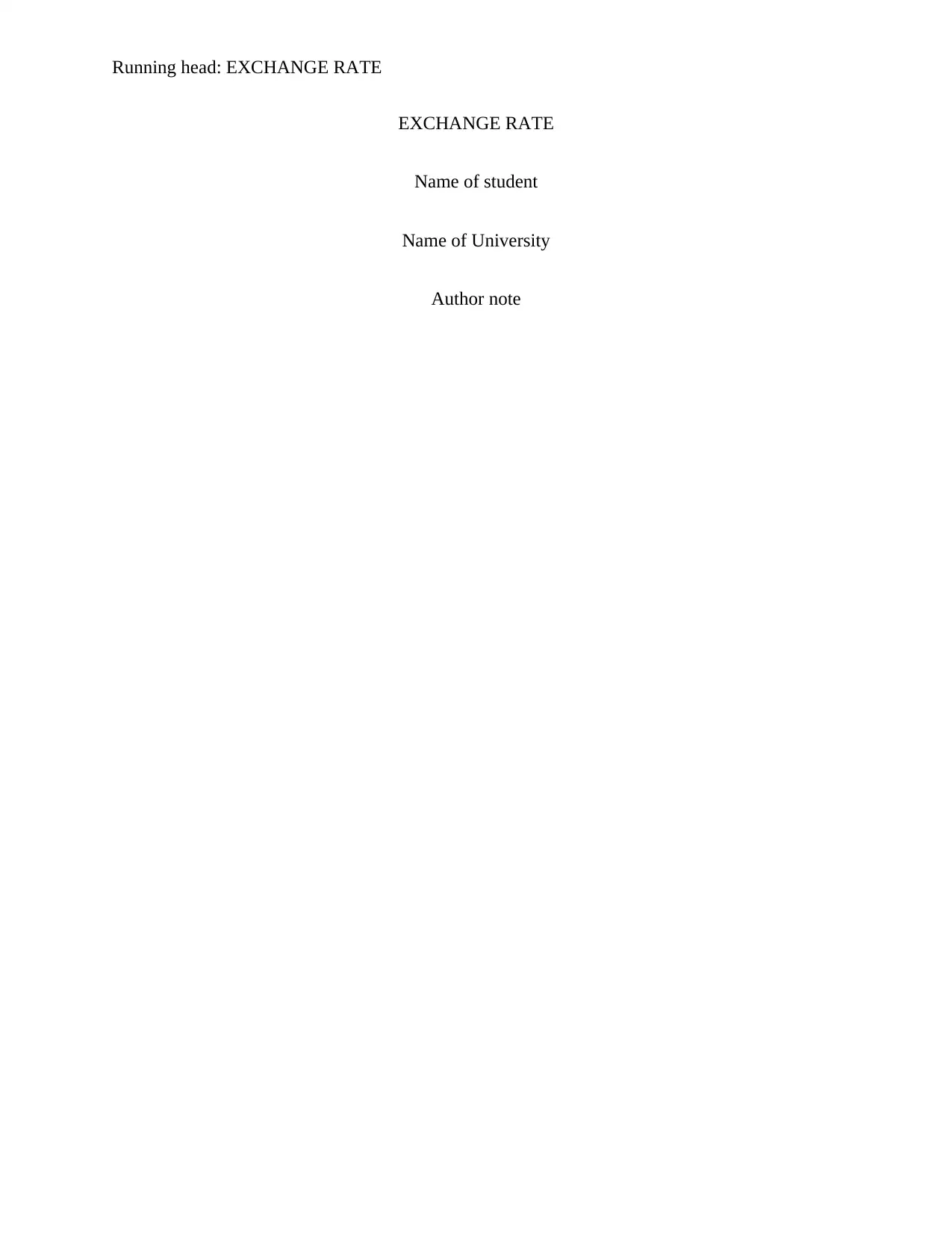
Running head: EXCHANGE RATE
EXCHANGE RATE
Name of student
Name of University
Author note
EXCHANGE RATE
Name of student
Name of University
Author note
Paraphrase This Document
Need a fresh take? Get an instant paraphrase of this document with our AI Paraphraser
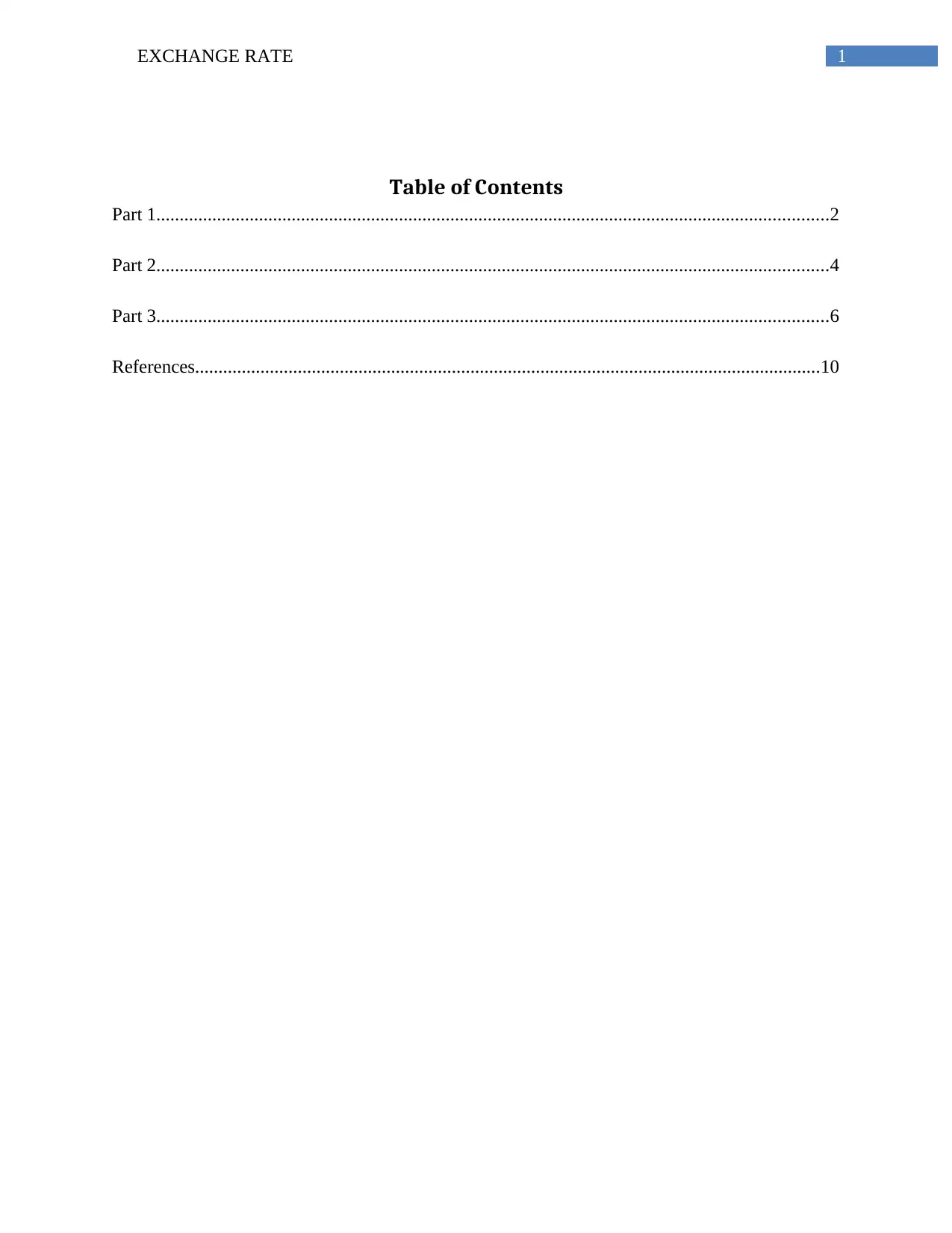
1EXCHANGE RATE
Table of Contents
Part 1................................................................................................................................................2
Part 2................................................................................................................................................4
Part 3................................................................................................................................................6
References......................................................................................................................................10
Table of Contents
Part 1................................................................................................................................................2
Part 2................................................................................................................................................4
Part 3................................................................................................................................................6
References......................................................................................................................................10
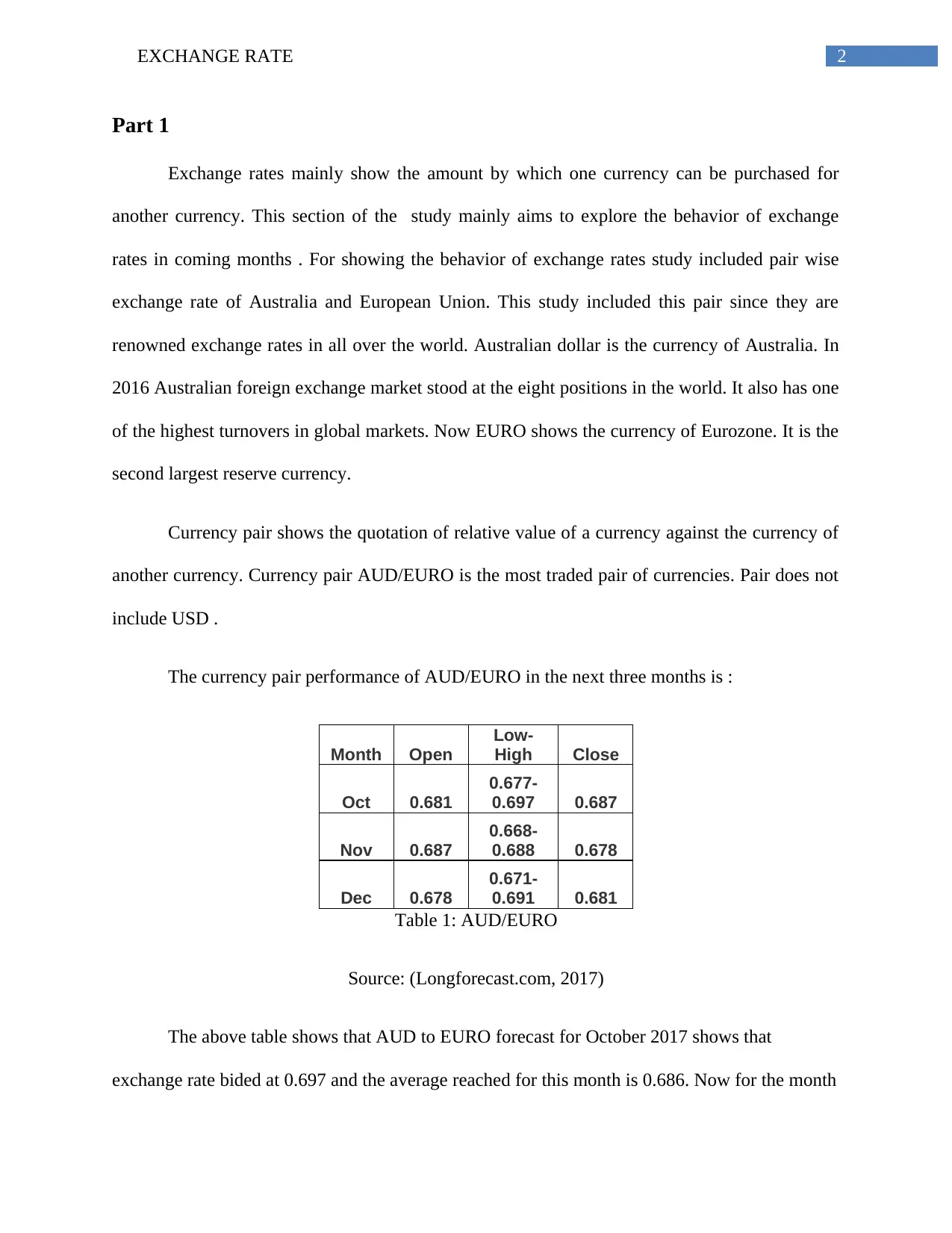
2EXCHANGE RATE
Part 1
Exchange rates mainly show the amount by which one currency can be purchased for
another currency. This section of the study mainly aims to explore the behavior of exchange
rates in coming months . For showing the behavior of exchange rates study included pair wise
exchange rate of Australia and European Union. This study included this pair since they are
renowned exchange rates in all over the world. Australian dollar is the currency of Australia. In
2016 Australian foreign exchange market stood at the eight positions in the world. It also has one
of the highest turnovers in global markets. Now EURO shows the currency of Eurozone. It is the
second largest reserve currency.
Currency pair shows the quotation of relative value of a currency against the currency of
another currency. Currency pair AUD/EURO is the most traded pair of currencies. Pair does not
include USD .
The currency pair performance of AUD/EURO in the next three months is :
Month Open
Low-
High Close
Oct 0.681
0.677-
0.697 0.687
Nov 0.687
0.668-
0.688 0.678
Dec 0.678
0.671-
0.691 0.681
Table 1: AUD/EURO
Source: (Longforecast.com, 2017)
The above table shows that AUD to EURO forecast for October 2017 shows that
exchange rate bided at 0.697 and the average reached for this month is 0.686. Now for the month
Part 1
Exchange rates mainly show the amount by which one currency can be purchased for
another currency. This section of the study mainly aims to explore the behavior of exchange
rates in coming months . For showing the behavior of exchange rates study included pair wise
exchange rate of Australia and European Union. This study included this pair since they are
renowned exchange rates in all over the world. Australian dollar is the currency of Australia. In
2016 Australian foreign exchange market stood at the eight positions in the world. It also has one
of the highest turnovers in global markets. Now EURO shows the currency of Eurozone. It is the
second largest reserve currency.
Currency pair shows the quotation of relative value of a currency against the currency of
another currency. Currency pair AUD/EURO is the most traded pair of currencies. Pair does not
include USD .
The currency pair performance of AUD/EURO in the next three months is :
Month Open
Low-
High Close
Oct 0.681
0.677-
0.697 0.687
Nov 0.687
0.668-
0.688 0.678
Dec 0.678
0.671-
0.691 0.681
Table 1: AUD/EURO
Source: (Longforecast.com, 2017)
The above table shows that AUD to EURO forecast for October 2017 shows that
exchange rate bided at 0.697 and the average reached for this month is 0.686. Now for the month
You're viewing a preview
Unlock full access by subscribing today!
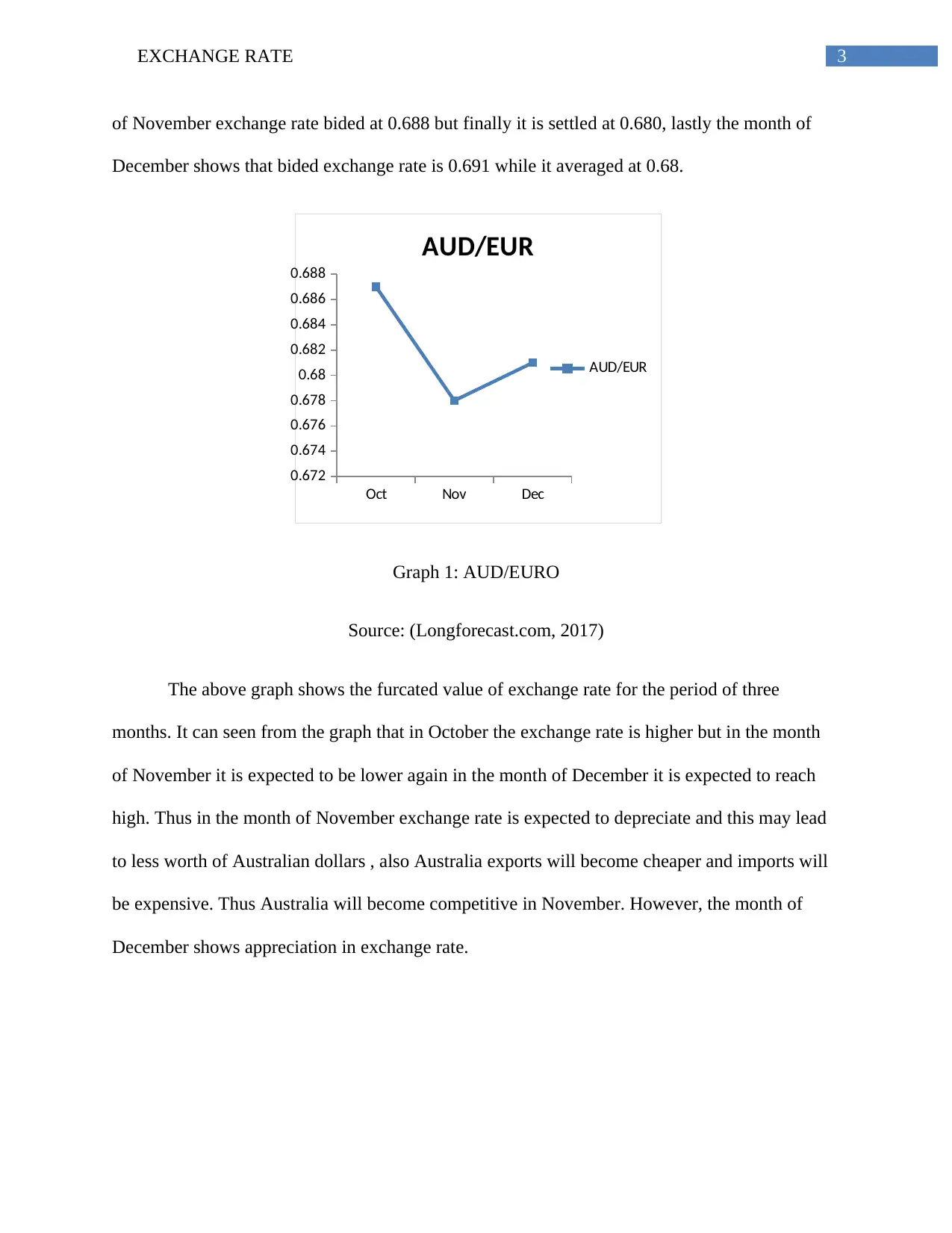
3EXCHANGE RATE
of November exchange rate bided at 0.688 but finally it is settled at 0.680, lastly the month of
December shows that bided exchange rate is 0.691 while it averaged at 0.68.
Oct Nov Dec
0.672
0.674
0.676
0.678
0.68
0.682
0.684
0.686
0.688
AUD/EUR
AUD/EUR
Graph 1: AUD/EURO
Source: (Longforecast.com, 2017)
The above graph shows the furcated value of exchange rate for the period of three
months. It can seen from the graph that in October the exchange rate is higher but in the month
of November it is expected to be lower again in the month of December it is expected to reach
high. Thus in the month of November exchange rate is expected to depreciate and this may lead
to less worth of Australian dollars , also Australia exports will become cheaper and imports will
be expensive. Thus Australia will become competitive in November. However, the month of
December shows appreciation in exchange rate.
of November exchange rate bided at 0.688 but finally it is settled at 0.680, lastly the month of
December shows that bided exchange rate is 0.691 while it averaged at 0.68.
Oct Nov Dec
0.672
0.674
0.676
0.678
0.68
0.682
0.684
0.686
0.688
AUD/EUR
AUD/EUR
Graph 1: AUD/EURO
Source: (Longforecast.com, 2017)
The above graph shows the furcated value of exchange rate for the period of three
months. It can seen from the graph that in October the exchange rate is higher but in the month
of November it is expected to be lower again in the month of December it is expected to reach
high. Thus in the month of November exchange rate is expected to depreciate and this may lead
to less worth of Australian dollars , also Australia exports will become cheaper and imports will
be expensive. Thus Australia will become competitive in November. However, the month of
December shows appreciation in exchange rate.
Paraphrase This Document
Need a fresh take? Get an instant paraphrase of this document with our AI Paraphraser
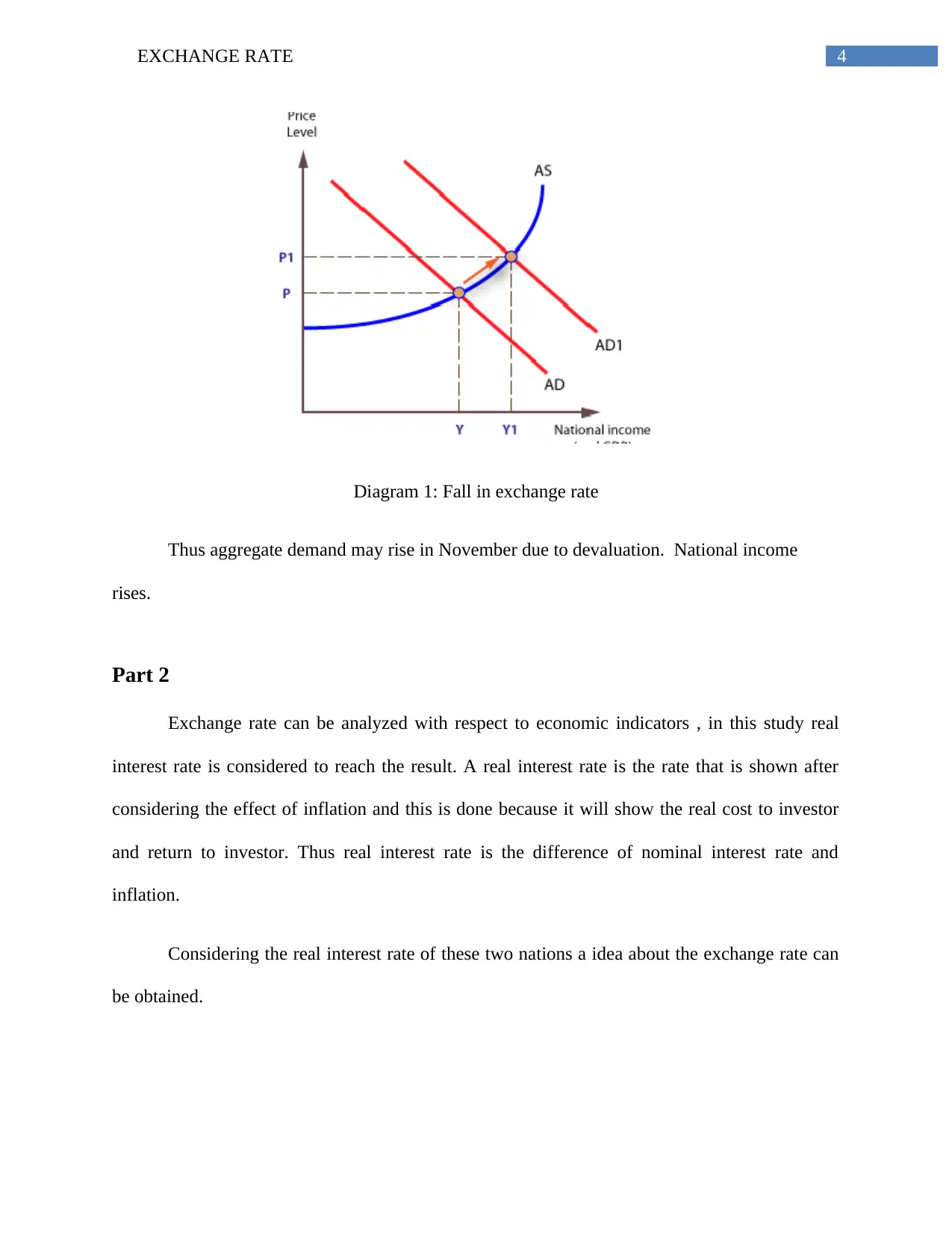
4EXCHANGE RATE
Diagram 1: Fall in exchange rate
Thus aggregate demand may rise in November due to devaluation. National income
rises.
Part 2
Exchange rate can be analyzed with respect to economic indicators , in this study real
interest rate is considered to reach the result. A real interest rate is the rate that is shown after
considering the effect of inflation and this is done because it will show the real cost to investor
and return to investor. Thus real interest rate is the difference of nominal interest rate and
inflation.
Considering the real interest rate of these two nations a idea about the exchange rate can
be obtained.
Diagram 1: Fall in exchange rate
Thus aggregate demand may rise in November due to devaluation. National income
rises.
Part 2
Exchange rate can be analyzed with respect to economic indicators , in this study real
interest rate is considered to reach the result. A real interest rate is the rate that is shown after
considering the effect of inflation and this is done because it will show the real cost to investor
and return to investor. Thus real interest rate is the difference of nominal interest rate and
inflation.
Considering the real interest rate of these two nations a idea about the exchange rate can
be obtained.
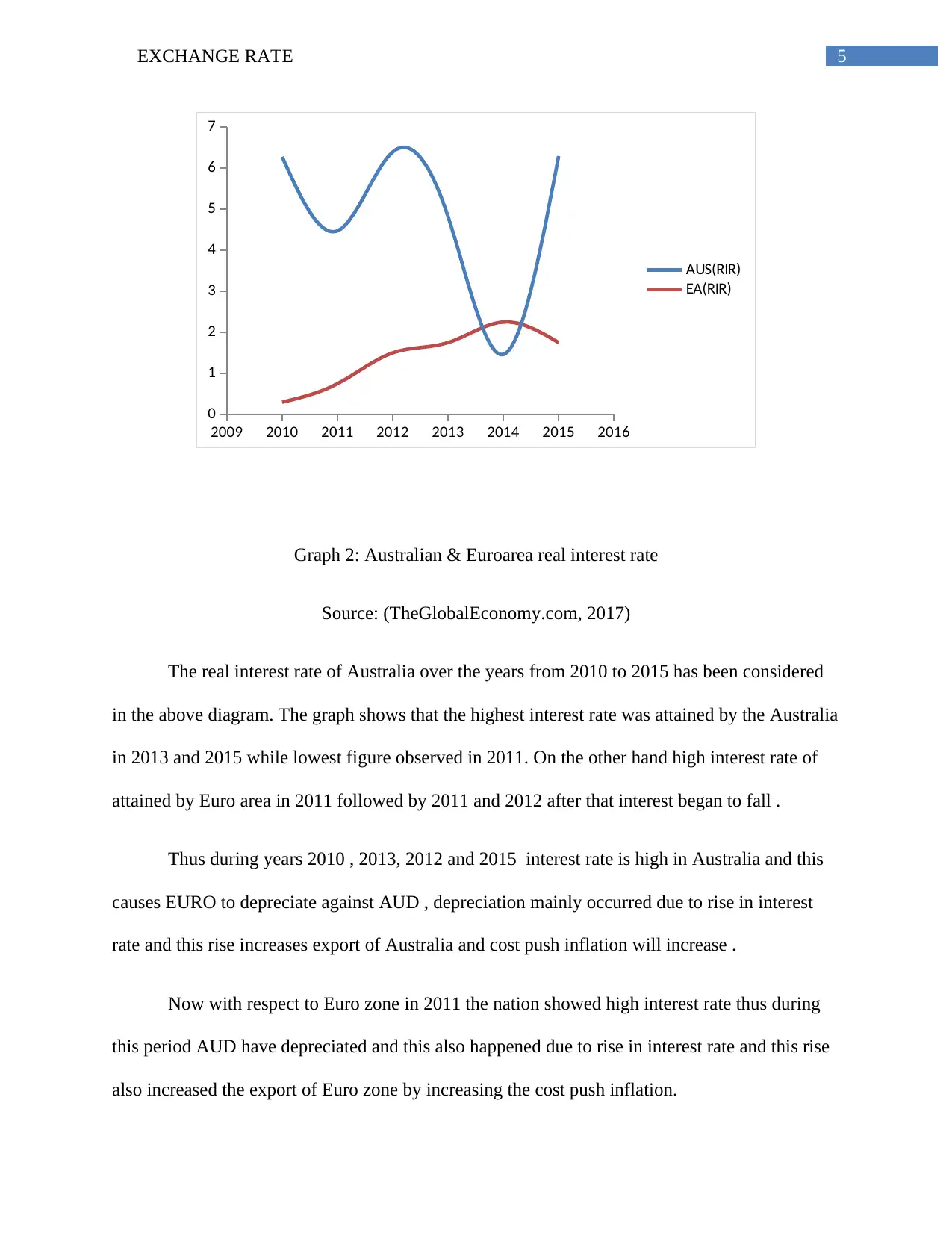
5EXCHANGE RATE
2009 2010 2011 2012 2013 2014 2015 2016
0
1
2
3
4
5
6
7
AUS(RIR)
EA(RIR)
Graph 2: Australian & Euroarea real interest rate
Source: (TheGlobalEconomy.com, 2017)
The real interest rate of Australia over the years from 2010 to 2015 has been considered
in the above diagram. The graph shows that the highest interest rate was attained by the Australia
in 2013 and 2015 while lowest figure observed in 2011. On the other hand high interest rate of
attained by Euro area in 2011 followed by 2011 and 2012 after that interest began to fall .
Thus during years 2010 , 2013, 2012 and 2015 interest rate is high in Australia and this
causes EURO to depreciate against AUD , depreciation mainly occurred due to rise in interest
rate and this rise increases export of Australia and cost push inflation will increase .
Now with respect to Euro zone in 2011 the nation showed high interest rate thus during
this period AUD have depreciated and this also happened due to rise in interest rate and this rise
also increased the export of Euro zone by increasing the cost push inflation.
2009 2010 2011 2012 2013 2014 2015 2016
0
1
2
3
4
5
6
7
AUS(RIR)
EA(RIR)
Graph 2: Australian & Euroarea real interest rate
Source: (TheGlobalEconomy.com, 2017)
The real interest rate of Australia over the years from 2010 to 2015 has been considered
in the above diagram. The graph shows that the highest interest rate was attained by the Australia
in 2013 and 2015 while lowest figure observed in 2011. On the other hand high interest rate of
attained by Euro area in 2011 followed by 2011 and 2012 after that interest began to fall .
Thus during years 2010 , 2013, 2012 and 2015 interest rate is high in Australia and this
causes EURO to depreciate against AUD , depreciation mainly occurred due to rise in interest
rate and this rise increases export of Australia and cost push inflation will increase .
Now with respect to Euro zone in 2011 the nation showed high interest rate thus during
this period AUD have depreciated and this also happened due to rise in interest rate and this rise
also increased the export of Euro zone by increasing the cost push inflation.
You're viewing a preview
Unlock full access by subscribing today!
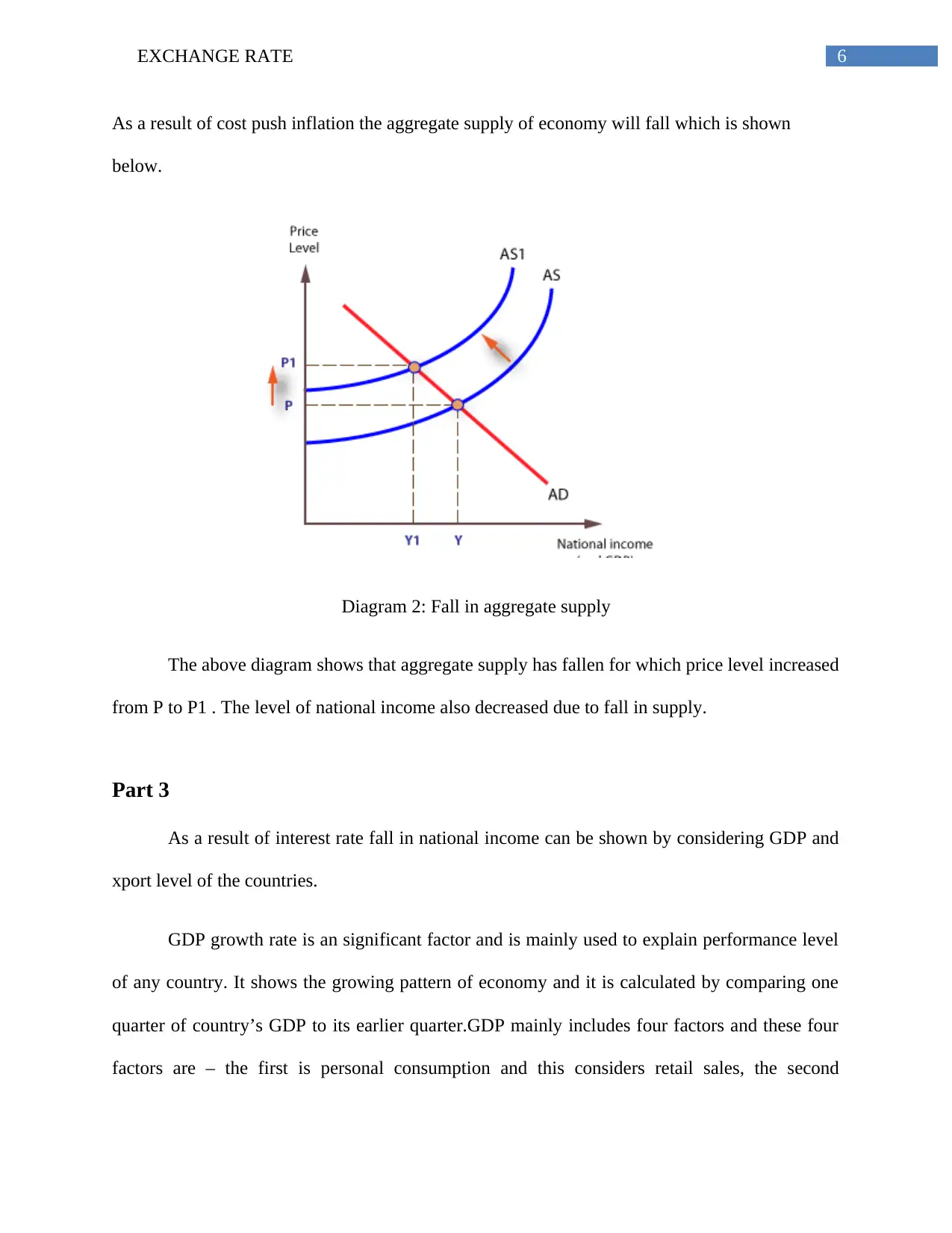
6EXCHANGE RATE
As a result of cost push inflation the aggregate supply of economy will fall which is shown
below.
Diagram 2: Fall in aggregate supply
The above diagram shows that aggregate supply has fallen for which price level increased
from P to P1 . The level of national income also decreased due to fall in supply.
Part 3
As a result of interest rate fall in national income can be shown by considering GDP and
xport level of the countries.
GDP growth rate is an significant factor and is mainly used to explain performance level
of any country. It shows the growing pattern of economy and it is calculated by comparing one
quarter of country’s GDP to its earlier quarter.GDP mainly includes four factors and these four
factors are – the first is personal consumption and this considers retail sales, the second
As a result of cost push inflation the aggregate supply of economy will fall which is shown
below.
Diagram 2: Fall in aggregate supply
The above diagram shows that aggregate supply has fallen for which price level increased
from P to P1 . The level of national income also decreased due to fall in supply.
Part 3
As a result of interest rate fall in national income can be shown by considering GDP and
xport level of the countries.
GDP growth rate is an significant factor and is mainly used to explain performance level
of any country. It shows the growing pattern of economy and it is calculated by comparing one
quarter of country’s GDP to its earlier quarter.GDP mainly includes four factors and these four
factors are – the first is personal consumption and this considers retail sales, the second
Paraphrase This Document
Need a fresh take? Get an instant paraphrase of this document with our AI Paraphraser
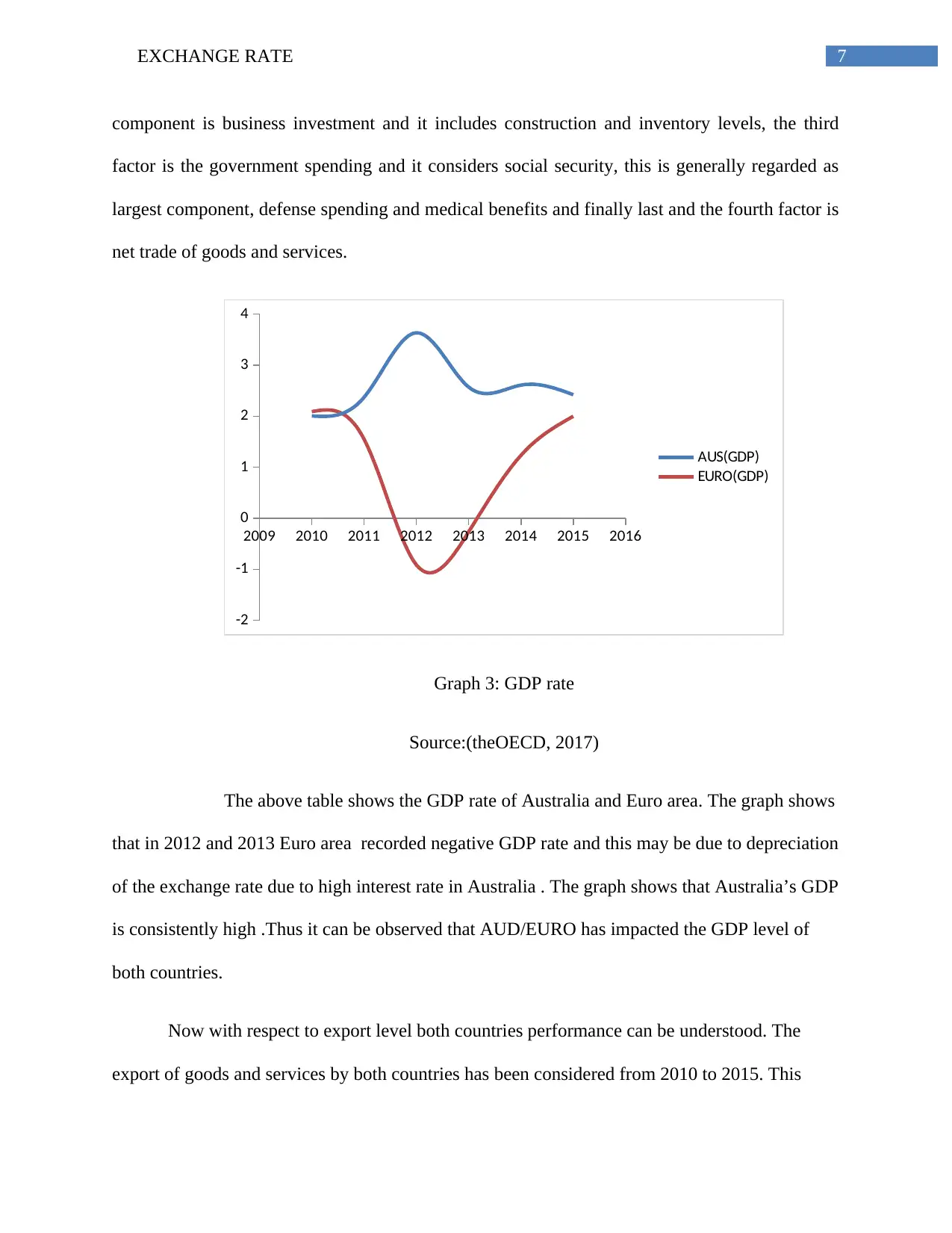
7EXCHANGE RATE
component is business investment and it includes construction and inventory levels, the third
factor is the government spending and it considers social security, this is generally regarded as
largest component, defense spending and medical benefits and finally last and the fourth factor is
net trade of goods and services.
2009 2010 2011 2012 2013 2014 2015 2016
-2
-1
0
1
2
3
4
AUS(GDP)
EURO(GDP)
Graph 3: GDP rate
Source:(theOECD, 2017)
The above table shows the GDP rate of Australia and Euro area. The graph shows
that in 2012 and 2013 Euro area recorded negative GDP rate and this may be due to depreciation
of the exchange rate due to high interest rate in Australia . The graph shows that Australia’s GDP
is consistently high .Thus it can be observed that AUD/EURO has impacted the GDP level of
both countries.
Now with respect to export level both countries performance can be understood. The
export of goods and services by both countries has been considered from 2010 to 2015. This
component is business investment and it includes construction and inventory levels, the third
factor is the government spending and it considers social security, this is generally regarded as
largest component, defense spending and medical benefits and finally last and the fourth factor is
net trade of goods and services.
2009 2010 2011 2012 2013 2014 2015 2016
-2
-1
0
1
2
3
4
AUS(GDP)
EURO(GDP)
Graph 3: GDP rate
Source:(theOECD, 2017)
The above table shows the GDP rate of Australia and Euro area. The graph shows
that in 2012 and 2013 Euro area recorded negative GDP rate and this may be due to depreciation
of the exchange rate due to high interest rate in Australia . The graph shows that Australia’s GDP
is consistently high .Thus it can be observed that AUD/EURO has impacted the GDP level of
both countries.
Now with respect to export level both countries performance can be understood. The
export of goods and services by both countries has been considered from 2010 to 2015. This
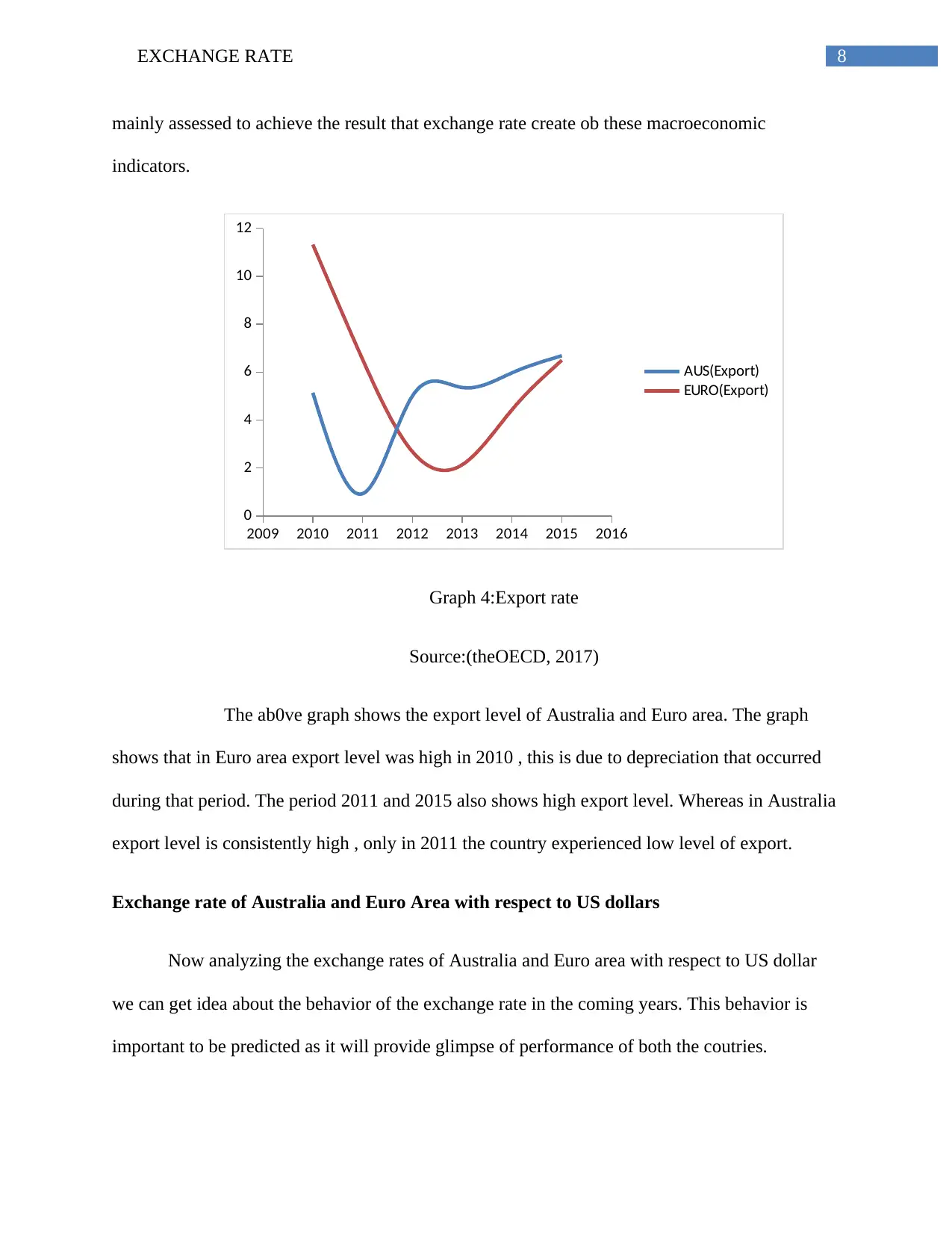
8EXCHANGE RATE
mainly assessed to achieve the result that exchange rate create ob these macroeconomic
indicators.
2009 2010 2011 2012 2013 2014 2015 2016
0
2
4
6
8
10
12
AUS(Export)
EURO(Export)
Graph 4:Export rate
Source:(theOECD, 2017)
The ab0ve graph shows the export level of Australia and Euro area. The graph
shows that in Euro area export level was high in 2010 , this is due to depreciation that occurred
during that period. The period 2011 and 2015 also shows high export level. Whereas in Australia
export level is consistently high , only in 2011 the country experienced low level of export.
Exchange rate of Australia and Euro Area with respect to US dollars
Now analyzing the exchange rates of Australia and Euro area with respect to US dollar
we can get idea about the behavior of the exchange rate in the coming years. This behavior is
important to be predicted as it will provide glimpse of performance of both the coutries.
mainly assessed to achieve the result that exchange rate create ob these macroeconomic
indicators.
2009 2010 2011 2012 2013 2014 2015 2016
0
2
4
6
8
10
12
AUS(Export)
EURO(Export)
Graph 4:Export rate
Source:(theOECD, 2017)
The ab0ve graph shows the export level of Australia and Euro area. The graph
shows that in Euro area export level was high in 2010 , this is due to depreciation that occurred
during that period. The period 2011 and 2015 also shows high export level. Whereas in Australia
export level is consistently high , only in 2011 the country experienced low level of export.
Exchange rate of Australia and Euro Area with respect to US dollars
Now analyzing the exchange rates of Australia and Euro area with respect to US dollar
we can get idea about the behavior of the exchange rate in the coming years. This behavior is
important to be predicted as it will provide glimpse of performance of both the coutries.
You're viewing a preview
Unlock full access by subscribing today!

9EXCHANGE RATE
2010 2011 2012 2013 2014 2015 2016
0
0.2
0.4
0.6
0.8
1
1.2
1.4
1.6
AUS(EXCH)
EURO(EXCH)
Graph 4:Exchanget rate
Source:(theOECD, 2017)
The graph shows that exchange rate of Australia is higher than that of Euro area.
This shows that Euro area performance as compared to Australia is low. A higher exchange rate
is always better. This is because, while exchange currencies, more of the foreign currency can be
bought. However, a lower exchange rate is better from selling currency point of view. A higher
exchange rate increases purchasing power parity of that country, and this is the reason that
Australia stands in 20th position in the world from PPP position
Recent Position of AUD and EURO
AUD has sustained advances against EURO. This is mainly due to most of the investors
sold Euro due to uncertainty about the European Central Bank. The currency pair AUD/EURO
continue to be higher as the forecast shows. Thus AUD holds EURO as risk sentiment
rises(Sushko,2016).
2010 2011 2012 2013 2014 2015 2016
0
0.2
0.4
0.6
0.8
1
1.2
1.4
1.6
AUS(EXCH)
EURO(EXCH)
Graph 4:Exchanget rate
Source:(theOECD, 2017)
The graph shows that exchange rate of Australia is higher than that of Euro area.
This shows that Euro area performance as compared to Australia is low. A higher exchange rate
is always better. This is because, while exchange currencies, more of the foreign currency can be
bought. However, a lower exchange rate is better from selling currency point of view. A higher
exchange rate increases purchasing power parity of that country, and this is the reason that
Australia stands in 20th position in the world from PPP position
Recent Position of AUD and EURO
AUD has sustained advances against EURO. This is mainly due to most of the investors
sold Euro due to uncertainty about the European Central Bank. The currency pair AUD/EURO
continue to be higher as the forecast shows. Thus AUD holds EURO as risk sentiment
rises(Sushko,2016).
Paraphrase This Document
Need a fresh take? Get an instant paraphrase of this document with our AI Paraphraser

10EXCHANGE RATE
References
Longforecast.com. (2017). AUD TO EURO AND EURO to AUD FORECAST 2017, 2018, 2019,
2020, 2021 - Long Forecast. [online] Available at: https://longforecast.com/aud-to-euro-forecast-
2017-20-2018-2019-2020-2021-euro-to-aud [Accessed 21 Sep. 2017].
Sushko, V., Borio, C., McCauley, R. and McGuire, P., 2016. BIS Working Papers
TheGlobalEconomy.com. (2017). Australia Real interest rate - data, chart |
TheGlobalEconomy.com.[online]Availableat:http://www.theglobaleconomy.com/Australia/
Real_interest_rate/ [Accessed 21 Sep. 2017].
TheOECD. (2017). Conversion rates - Exchange rates - OECD Data. [online] Available at:
https://data.oecd.org/conversion/exchange-rates.htm [Accessed 17 Sep. 2017].
References
Longforecast.com. (2017). AUD TO EURO AND EURO to AUD FORECAST 2017, 2018, 2019,
2020, 2021 - Long Forecast. [online] Available at: https://longforecast.com/aud-to-euro-forecast-
2017-20-2018-2019-2020-2021-euro-to-aud [Accessed 21 Sep. 2017].
Sushko, V., Borio, C., McCauley, R. and McGuire, P., 2016. BIS Working Papers
TheGlobalEconomy.com. (2017). Australia Real interest rate - data, chart |
TheGlobalEconomy.com.[online]Availableat:http://www.theglobaleconomy.com/Australia/
Real_interest_rate/ [Accessed 21 Sep. 2017].
TheOECD. (2017). Conversion rates - Exchange rates - OECD Data. [online] Available at:
https://data.oecd.org/conversion/exchange-rates.htm [Accessed 17 Sep. 2017].
1 out of 11
Your All-in-One AI-Powered Toolkit for Academic Success.
+13062052269
info@desklib.com
Available 24*7 on WhatsApp / Email
![[object Object]](/_next/static/media/star-bottom.7253800d.svg)
Unlock your academic potential
© 2024 | Zucol Services PVT LTD | All rights reserved.
